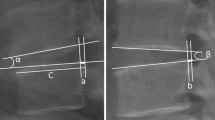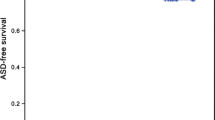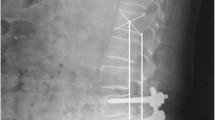Abstract
Background
Adjacent segment disease (ASDz) is a potential complication following lumbar spinal fusion. A common nomenclature based on etiology and ASDz type does not exist and is needed to assist with clinical prognostication, decision making, and management.
Questions/Purposes
The objective of this study was to develop an etiology-based classification system for ASDz following lumbar fusion.
Methods
We conducted a retrospective chart review of 65 consecutive patients who had undergone both a lumbar fusion performed by a single surgeon and a subsequent procedure for ASDz. We established an etiology-based classification system for lumbar ASDz with the following six categories: “degenerative” (degenerative disc disease or spondylosis), “neurologic” (disc herniation, stenosis), “instability” (spondylolisthesis, rotatory subluxation), “deformity” (scoliosis, kyphosis), “complex” (fracture, infection), or “combined.” Based on this scheme, we determined the rate of ASDz in each etiologic category.
Results
Of the 65 patients, 27 (41.5%) underwent surgery for neurogenic claudication or radiculopathy for adjacent-level stenosis or disc herniation and were classified as “neurologic.” Ten patients (15.4%) had progressive degenerative disc pathology at the adjacent level and were classified as “degenerative.” Ten patients (15.4%) had spondylolisthesis or instability and were classified as “instability,” and three patients (4.6%) required revision surgery for adjacent-level kyphosis or scoliosis and were classified as “deformity.” Fifteen patients (23.1%) had multiple diagnoses that included a combination of categories and were classified as “combined.”
Conclusion
This is the first study to propose an etiology-based classification scheme of ASDz following lumbar spine fusion. This simple classification system may allow for the grouping and standardization of patients with similar pathologies and thus for more specific pre-operative diagnoses, personalized treatments, and improved outcome analyses.

Similar content being viewed by others
References
Boos N, Rieder R, Schade V, Spratt KF, Semmer N, Aebi M. 1995 Volvo Award in clinical sciences. The diagnostic accuracy of magnetic resonance imaging, work perception, and psychosocial factors in identifying symptomatic disc herniations. Spine (Phila Pa 1976). 20(24):2613–2625.
Bydon A, Xu R, De la Garza-Ramos R, et al. Adjacent segment disease after anterior cervical discectomy and fusion: Incidence and clinical outcomes of patients requiring anterior versus posterior repeat cervical fusion. Neurosurgery. 2014;74(2):139–146.
Carrier CS, Bono CM, Lebl DR. Evidence-based analysis of adjacent segment degeneration and disease after ACDF: a systematic review. Spine J. 2013;13(10):1370–1378.
Cho SK, Riew KD. Adjacent segment disease following cervical spine surgery. J Am Acad Orthop Surg. 2013. 21(1):3–11
Denis F. The three column spine and its significance in the classification of acute thoracolumbar spinal injuries. Spine (Phila Pa 1976). 1983;8(8):817–831.
Etebar S, Cahill DW. Risk factors for adjacent-segment failure following lumbar fixation with rigid instrumentation for degenerative instability. J Neurosurg. 1999;90(2 Suppl):163–169.
Garbuz DS, Masri BA, Esdaile J, Duncan CP. Classification systems in orthopaedics. J Am Acad Orthop Surg. 2002;10(4):290–297.
Gertzbein SD, Court-Brown CM. Flexion-distraction injuries of the lumbar spine. Mechanisms of injury and classification. Clin Orthop Relat Res. 1988;227:52–60.
Ghiselli G, Wang JC, Bhatia NN, Hsu WK, Dawson EG. Adjacent segment degeneration in the lumbar spine. J Bone Joint Surg Am. 2004;86(7):1497–1503.
Ghogawala Z, Dziura J, Butler WE, Dai F, Terrin N, et al. Laminectomy plus fusion versus laminectomy alone for lumbar spondylolisthesis. N Engl J Med. 2016;374(15):1424–1434.
Harrop JS, Youssef JA, Maltenfort M, et al. Lumbar adjacent segment degeneration and disease after arthrodesis and total disc arthroplasty. Spine (Phila Pa 1976). 2008;33(15):1701–1707.
Helgeson MD, Bevevino AJ, Hilibrand AS. Update on the evidence for adjacent segment degeneration and disease. Spine J. 2013;13(3):342–351.
Hilibrand AS, Robbins M. Adjacent segment degeneration and adjacent segment disease: the consequences of spinal fusion? Spine J. 2004;4(6 Suppl):190S–194S.
Ito K, Creemers L. Mechanisms of intervertebral disk degeneration/injury and pain: a review. Global Spine J. 2013;3(3):145–152.
Kraemer P, Fehlings MG, Hashimoto R, et al. A systematic review of definitions and classification systems of adjacent segment pathology. Spine (Phila Pa 1976). 2012;37(22 Suppl):S31–S39.
Lee CS, Hwang CJ, Lee S-W, et al. Risk factors for adjacent segment disease after lumbar fusion. Eur Spine J. 2009;18(11):1637–1643.
Levin DA, Hale JJ, Bendo JA. Adjacent segment degeneration following spinal fusion for degenerative disc disease. Bull NYU Hosp Jt Dis. 2007;65(1):29–36.
Mannion AF, Leivseth G, Brox J-I, Fritzell P, Hägg O, Fairbank JCT. ISSLS prize winner: long-term follow-up suggests spinal fusion is associated with increased adjacent segment disc degeneration but without influence on clinical outcome results of a combined follow-up from 4 randomized controlled trials. Spine (Phila Pa 1976). 2014;39(17):1373–1383.
Meyerding HW. Low backache and sciatic pain associated with spondylolisthesis and protruded intervertebral disc: incidence, significance, and treatment. J Bone Joint Surg Am. 1941;23(2):461
Norvell DC, Dettori JR, Fehlings MG, Fourney DR, Chapman JR. Methodology for the systematic reviews on an evidence-based approach for the management of chronic low back pain. Spine (Phila Pa 1976). 2011;36(21 Suppl):S10–S18.
Omair A, Mannion AF, Holden M, et al. Age and pro-inflammatory gene polymorphisms influence adjacent segment disc degeneration more than fusion does in patients treated for chronic low back pain. Eur Spine J. 2016;25(1):2–13.
Pannell WC, Savin DD, Scott TP, Wang JC, Daubs MD. Trends in the surgical treatment of lumbar spine disease in the United States. Spine J. 2015;15(8):1719–1727.
Park P, Garton HJ, Gala VC, Hoff JT, McGillicuddy JE. Adjacent segment disease after lumbar or lumbosacral fusion: review of the literature. Spine (Phila Pa 1976). 2004;29(17):1938–1944.
Radcliff KE, Kepler CK, Jakoi A, et al. Adjacent segment disease in the lumbar spine following different treatment interventions. Spine J. 2013;13(10):1339–1349.
Rothenfluh DA, Mueller DA, Rothenfluh E, Min K. Pelvic incidence-lumbar lordosis mismatch predisposes to adjacent segment disease after lumbar spinal fusion. Eur Spine J. 2015;24(6):1251–1258.
Roussouly P, Gollogly S, Berthonnaud E, Dimnet J. Classification of the normal variation in the sagittal alignment of the human lumbar spine and pelvis in the standing position. Spine (Phila Pa 1976). 2005;30(3):346–533.
Scemama C, Magrino B, Gillet P, Guigui P. Risk of adjacent-segment disease requiring surgery after short lumbar fusion: results of the French Spine Surgery Society Series. J Neurosurg Spine. 2016;25(1):46–51.
Thalgott JS, Albert TJ, Vaccaro AR, et al. A new classification system for degenerative disc disease of the lumbar spine based on magnetic resonance imaging, provocative discography, plain radiographs and anatomic considerations. Spine J. 2004;4(6, Suppl):S167–S172.
Virk SS, Niedermeier S, Yu E, Khan SN. Adjacent segment disease. Orthopedics. 2014;37(8):547–555.
Wai EK, Santos ERG, Morcom RA, Fraser RD. Magnetic resonance imaging 20 years after anterior lumbar interbody fusion. Spine (Phila Pa 1976). 2006;31(17):1952–1956.
Wiltse LL, Newman PH, Macnab I. Classification of spondylolysis and spondylolisthesis. Clin Orthop Relat Res. 1976;(117):23–29.
Xia X-P, Chen H-L, Cheng H-B. Prevalence of adjacent segment degeneration after spine surgery: a systematic review and meta-analysis. Spine (Phila Pa 1976). 2013;38(7):597–608.
Yang JY, Lee J-K, Song H-S. The impact of adjacent segment degeneration on the clinical outcome after lumbar spinal fusion. Spine (Phila Pa 1976). 2008;33(5):503–507.
Yoshihara H, Yoneoka D. National trends in the surgical treatment for lumbar degenerative disc disease: United States, 2000 to 2009. Spine J. 2015;15(2):265–271.
Zhang C, Berven SH, Fortin M, Weber MH. Adjacent segment degeneration versus disease after lumbar spine fusion for degenerative pathology. Clin Spine Surg. 2016;29(1):21–29.
Author information
Authors and Affiliations
Corresponding author
Ethics declarations
Conflict of Interest
Garrett K. Harada, MD, Arash J. Sayari, MD, Benjamin C. Mayo, MD, Jannat M. Khan, BS, Arya G. Varthi, MD, and Alem Yacob, MD, declare that they have no conflicts of interest. Philip K. Louie, MD, reports stock or stock options from StreaMD, outside the submitted work. Dino Samartzis, DSc, reports board or committee membership at AOSpine and International Society for the Study of the Lumbar Spine; publishing royalties from BMC Scoliosis and Spinal Disorders and Elsevier; and editorial or governing board membership from Global Spine Journal, Scoliosis and Spinal Disorders, and Spine Journal, outside the submitted work. Howard S. An, MD, reports royalties from U & I Corporation and Zimmer Biomet; stock ownership in Articular Engineering, Medyssey Inc., and Spinal Kinetics; consulting fees from Bioventus and Stryker; editorial board membership at American Journal of Orthopaedics and Spine Journal; and research support from Medyssey Inc. and SpinalCyte LLC, outside the submitted work.
Human/Animal Rights
All procedures followed were in accordance with the ethical standards of the responsible committee on human experimentation (institutional and national) and with the Helsinki Declaration of 1975, as revised in 2013.
Informed Consent
Informed consent was waived from all patients for being included in this study.
Required Author Forms
Disclosure forms provided by the authors are available with the online version of this article.
Additional information
Level of Evidence: Level IV: Therapeutic Study
Rights and permissions
About this article
Cite this article
Louie, P.K., Harada, G.K., Sayari, A.J. et al. Etiology-Based Classification of Adjacent Segment Disease Following Lumbar Spine Fusion. HSS Jrnl 16, 130–136 (2020). https://doi.org/10.1007/s11420-019-09723-w
Received:
Accepted:
Published:
Issue Date:
DOI: https://doi.org/10.1007/s11420-019-09723-w




